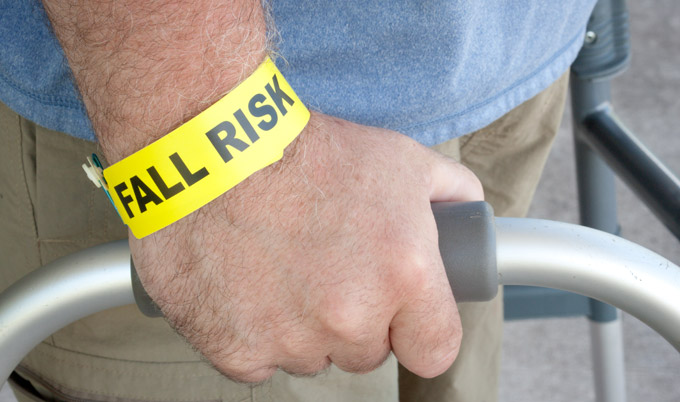Falls study
Virtual reality could enhance treadmill training to prevent falls
Published on: 12 August 2016
Combining virtual reality and treadmill training helps prevent falls in older adults better than treadmill training alone, according to a new trial.
The authors, involving experts from Newcastle University, say that the intervention, which combines the physical and cognitive aspects of walking, could potentially be used in gyms, rehabilitation centres or nursing homes to improve safe walking and prevent falls in older adults or people with disorders which affect movement such as Parkinson’s disease.
Findings of the study have been published in The Lancet.
Falls in adults aged 65 and over account for 1-2% of all healthcare expenditure in high-income countries. As many as 30% of older adults living in the community, and 60-80% of older adults with mild cognitive impairment, dementia, or Parkinson’s disease, fall at least once a year.

Dangers of falls for older adults
Falls can cause injuries, loss of independence, disability, institutionalisation, and death. Even without injuries, falls often lead to fear of falling, avoiding leaving the house, and depression, which in turn often leads to inactivity, muscle weakness, impaired balance and gait, more falls and more social isolation.
Newcastle University is the only UK site of the international trial. Researchers enrolled 302 participants from clinical sites in the UK, Belgium, Israel, Italy, the Netherlands, between 2013 and 2015.
All participants were aged 60-90, were able to walk at least 5 minutes unassisted, on stable medication, and had reported at least two falls in the six months before the start of the study. Nearly half of all participants had Parkinson’s disease, and some had mild cognitive impairment.
Participants were assigned to treadmill training with virtual reality, or treadmill training alone. The virtual reality component consisted of a camera that captured the movement of participants’ feet and projected it onto a screen in front of the treadmill, so that participants could ‘see’ their feet walking on the screen in real time.
The game-like simulation was designed to reduce the risk of falls in older adults by including real life challenges such as avoiding and stepping over obstacles like puddles or hurdles, and navigating pathways.
Results of study
On average, participants in each group took part in 16 training sessions over six weeks, with each session lasting about 45 minutes. Fall rates were recorded in the six months following the end of the training. Prior to training, the treadmill only group had an average of 10.7 falls per six months, and the treadmill plus virtual reality group averaged 11.9 falls per six months.
During the six months after training, the incident rate of falls decreased in both groups, however there was a significant advantage of cognitive-motor treadmill training (called V-TIME) with a 42% lower fall incident rate compared to treadmill training alone.
The biggest improvement was seen in participants with Parkinson’s disease, and the authors suggest that this could be due to a number of factors, including that they had higher rates of falls at the start of the study, or that virtual reality was able to help improve cognitive and motor skills which are affected in Parkinson’s disease.
In the future, interventions of this type could be used in gyms, rehabilitation centres or nursing homes to prevent falls in older adults or people with movement disorders. However, the authors warn that the study was not powered to measure differences in between sub-groups, so further research is needed to evaluate these explanations.
Newcastle University’s involvement
Professor Lynn Rochester, from Newcastle University’s Institute of Neuroscience, was co-applicant and local lead for the study, which was conducted at the Clinical Ageing Research Unit, Campus for Ageing and Vitality.
She said: “Being part of a consortium of internationally renowned researchers that has made a significant contribution to falls prevention has been an exciting and rewarding experience.
“Recognition of the complexity of walking in the real-world, the increased cognitive demands and associated falls risk underpinned the type of contemporary rehabilitation approach evaluated in V-TIME. This shows the important place of rehabilitation combined with novel technological developments for effective prevention of falls in the future.”
There were a number of limitations in the trial, including that the follow-up period for participants in this trial was only six months per patient, so further research will be needed to see if there is a long-term effect and whether a maintenance training period could help to extend the benefits of training. Furthermore, although this is the largest study of its kind so far, the number of participants involved was small, and included older people who had already had falls.
Future studies should explore whether this type of intervention could be used as a preventative measure for all older people to help them avoid falls.
Reference
Anat Mirelman, Lynn Rochester, Inbal Maidan, Silvia Del Din, Lisa Alcock, Freek Nieuwhof, Marcel Olde Rikkert, Bastiaan Bloem, Elisa Pelosin, Laura Avanzino, Giocanni Abbruzzese, Kim Dockx, Esther Bekkers, Nir Giladi, Alice Nieuwboer & Jeffrey M. Hausdorff, (2016)
Press release adapted with thanks to The Lancet



